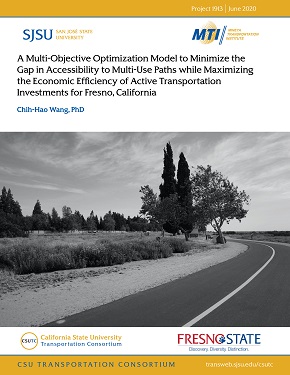- 408-924-7560
- mineta-institute@sjsu.edu
- Donate
A Multi-Objective Optimization Model to Minimize the Gap in Accessibility to Multi- Use Paths While Maximizing the Economic Efficiency of Active Transportation Investments for Fresno, California
This research examines the accessibility to multi-use paths in a variety of neighborhoods in Fresno, California. This study aims to develop a multi-objective optimization modeling framework to be used by decision makers in transportation and policy to maximize the total accessibility to multi-use paths across the city while minimizing the gap between low- and high- accessibility neighborhoods by an optimal allocation of active transportation. Researchers calculate accessibility to multi-use paths by measuring the total length of multi-use paths (walkway and bikeway) a resident could reach from their own Census block group with a 30-minute cycling ride. The study employs a geographically weighted regression (GWR) model to capture the local relationships between accessibility to multi-use paths and previous transportation investments (walkways, bikeways, and primary and secondary roads), while controlling for other socioeconomic factors. The marginal-effect analysis for the GWR results categorizes the areas within Fresno into economically efficient, inefficient, and indifferent locations for further investments. The researchers embed the GWR results into a multi-objective optimization modeling framework to improve accessibility to multi-use paths over the city and simultaneously address inequality in active-transportation accessibility. This research provides decision makers with insight into the problem of making of an economically-efficient and socially-equal active transportation plan accessible to people from diverse backgrounds with the ultimate goal of fostering public health.
CHIH-HAO WANG, PhD
Chih-Hao Wang is an associate professor of the Department of Geography and City & Regional Planning at California State University, Fresno, where he has taught since 2014. He received his PhD (2013) and Master’s (2010) degrees in City and Regional Planning from The Ohio State University. Dr. Wang’s research focuses on environmental planning from the perspective of natural hazard mitigation. Another of his research interests is the application of spatial statistics to analyze spatial or social interactions in the earthquake process, as well as water management, transportation planning, and community development. His research has been published in journals in areas of environmental planning, transportation, and geography.
-
Contact Us
San José State University One Washington Square, San Jose, CA 95192 Phone: 408-924-7560 Email: mineta-institute@sjsu.edu






